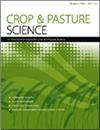Review of quantitative sensitivity of faba bean physiology to temperature and soil-water deficit
IF 1.9
4区 农林科学
Q2 AGRICULTURE, MULTIDISCIPLINARY
引用次数: 1
Abstract
ABSTRACT Faba bean (Vicia faba L.) is an important component of cropping systems in cool, arid environments. However, no review has specifically focused on the quantitative sensitivity of physiological processes in faba bean to low temperature and water deficits. The objective of this review was to examine published functional relationships between physiological activity and these environmental variables. Among faba bean genotypes, temperature generally resulted in a consistent linear response in plant ontogeny and leaf area development. By contrast, nitrogen fixation exhibited a sharp threshold response to temperature such that at temperatures below ~13.5–15°C faba bean had virtually no nitrogen fixation activity. This inability to fix nitrogen under cool temperatures is likely to be a major weakness for faba bean in cool-season production systems. Water deficit also had a large impact on the physiology of faba bean. Ontogeny was generally shortened when plants were subjected to drought, resulting in major yield decreases. Genotypic differences within faba bean have been identified for initiation of partial stomata closure at high soil-water content, resulting in possible soil-water conservation in the field. Also, differences among genotypes have been identified in the sensitivity of nitrogen fixation activity to water deficits. Finally, collectively the reviewed functional relationships have been applied to simulation analysis of the geospatial impact of irrigation regimes and of sowing date for faba bean production. These geospatial studies offered insights on options to improve faba bean management.蚕豆生理学对温度和土壤水分亏缺的定量敏感性研究进展
蚕豆(Vicia Faba L.)是凉爽干旱环境下种植系统的重要组成部分。然而,目前还没有专门研究蚕豆生理过程对低温和缺水的定量敏感性。本综述的目的是检查已发表的生理活动与这些环境变量之间的功能关系。在不同基因型的蚕豆中,温度对植物个体发育和叶面积发育的线性响应基本一致。相比之下,蚕豆固氮对温度表现出强烈的阈值响应,在低于~13.5 ~ 15℃的温度下,蚕豆几乎没有固氮活性。这种无法在低温下固定氮可能是蚕豆在冷季生产系统中的主要弱点。水分亏缺对蚕豆生理也有较大影响。植物在干旱条件下,个体发育时间普遍缩短,导致产量大幅度下降。在高土壤含水量条件下,蚕豆内部的基因型差异导致了部分气孔关闭的启动,从而可能导致田间水土保持。此外,不同基因型的固氮活性对水分缺乏的敏感性也存在差异。最后,将所综述的功能关系应用于灌溉制度和播种日期对蚕豆生产的地理空间影响的模拟分析。这些地理空间研究为改进蚕豆管理的选择提供了见解。
本文章由计算机程序翻译,如有差异,请以英文原文为准。
求助全文
约1分钟内获得全文
求助全文
来源期刊

Crop & Pasture Science
AGRICULTURE, MULTIDISCIPLINARY-
CiteScore
4.20
自引率
15.80%
发文量
111
审稿时长
3 months
期刊介绍:
Crop and Pasture Science (formerly known as Australian Journal of Agricultural Research) is an international journal publishing outcomes of strategic research in crop and pasture sciences and the sustainability of farming systems. The primary focus is broad-scale cereals, grain legumes, oilseeds and pastures. Articles are encouraged that advance understanding in plant-based agricultural systems through the use of well-defined and original aims designed to test a hypothesis, innovative and rigorous experimental design, and strong interpretation. The journal embraces experimental approaches from molecular level to whole systems, and the research must present novel findings and progress the science of agriculture.
Crop and Pasture Science is read by agricultural scientists and plant biologists, industry, administrators, policy-makers, and others with an interest in the challenges and opportunities facing world agricultural production.
Crop and Pasture Science is published with the endorsement of the Commonwealth Scientific and Industrial Research Organisation (CSIRO) and the Australian Academy of Science.
 求助内容:
求助内容: 应助结果提醒方式:
应助结果提醒方式:


